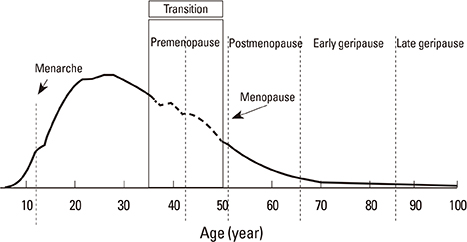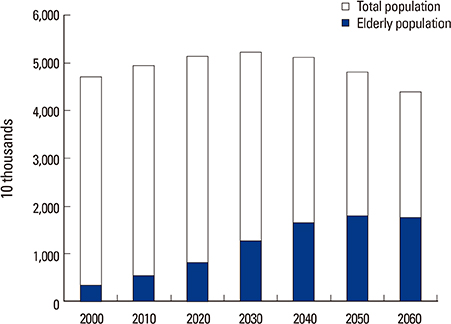J Bone Metab.
2015 Feb;22(1):23-28. 10.11005/jbm.2015.22.1.23.
The Demographic Changes of Menopausal and Geripausal Women in Korea
- Affiliations
-
- 1Department of Obstetrics and Gynecology, College of Medicine, Chung-Ang University, Seoul, Korea. hmpark52@hanmail.net
- KMID: 2170061
- DOI: http://doi.org/10.11005/jbm.2015.22.1.23
Abstract
- BACKGROUND
Osteoporosis and resultant fracture seems to be the most common skeletal disease, affecting female exclusively. Osteoporosis increases exponentially with menopause and age. Therefore the demographic data seems to be the most important & fundamental for the study of osteoporosis epidemiology.
METHODS
This study was to analyzed population projection from 1960 to 2060. We evaluated the demographic change of female, postmenopausal and elderly geripausal population in South Korea using Korean statistical information service database as basic fundamental data for osteoporosis epidemiology.
RESULTS
According to population projection, the total female population will be exceeds the total male population since 2015 and maximize up to 2030. In 2030, nearly half of female will become postmenopausal and one fourth of women elderly will be geripausal. Of total female population in 2060, the proportion of postmenopausal women will be increased up to 59.8%.
CONCLUSIONS
According to population projection in South Korea, six of ten women in 2060 will be postmenopausal and seven of ten postmenopausal women geripausal. As expected to increase proportion of elderly women, dramatic rise of osteoporosis and osteoporotic fracture also expected. Health providers pay more attention to postmenopausal and geripausal women health care.
Keyword
MeSH Terms
Figure
Cited by 1 articles
-
Prevalence of Sarcopenia Adjusted Body Mass Index in the Korean Woman Based on the Korean National Health and Nutritional Examination Surveys
Hyoung-Moo Park, Yong-Chan Ha, Jun-Il Yoo, Hyun-Jun Ryu
J Bone Metab. 2016;23(4):243-247. doi: 10.11005/jbm.2016.23.4.243.
Reference
-
1. Statistics Korea. Population projections for Korea: 2010-2060. Daejeon: Statistics Korea;2011.2. Kim S. The challenge of rapid ageing and low fertility in Korea. Milwaukee, WI: University of Wisconsin-Milwaukee.3. World Health Organization. Definition of an older or elderly person. 2013. cited by 2014 May 5. Available from: http://www.who.int/healthinfo/survey/ageingdefnolder/en/.4. Ortman JM, Velkoff VA, Hogan H. An aging nation: the older population in the United States. Washington, DC: U.S. Census Bureau;2014. Report No.: Current Population Reports, P25-1140.5. United Nations, Department of Economic and Social Affairs, Population Division. World population ageing 2013. New York, NY: United Nations;2013.6. Statistics Korea. 2013 statistics on the aged. Daejeon: Statistics Korea;2013.7. Jones CM, Boelaert K. The endocrinology of ageing: a mini-review. Gerontology;2014. http://dx.doi.org/10.1159/000367692.8. Ministry of Health & Welfare, Korea Centers for Disease Control & Prevention. Korea health statistics 2012: Korea national health and nutrition examination survey (KNHANES V-3). Seoul: Ministry of Health & Welfare;2013.9. Sweed HS, Elawam AE, Nabeel AM, et al. Postmenopausal symptoms among Egyptian geripausal women. East Mediterr Health J. 2012; 18:213–220.
Article10. Berek JS, Berek DL, Hengst TC, editors. Berek & Novak's gynecology. 15 ed. Philadelphia, PA: Wolters Kluwer Health/Lippincott Williams & Wilkins;2012.11. Eskin BA. The menopause: endocrinologic basis and management options. 5th ed. Abingdon, UK: Informa Healthcare;2007.12. Meunier PJ. Osteoporosis: diagnosis and management. London, UK: CRC Press;1998.13. Choi YJ, Oh HJ, Kim DJ, et al. The prevalence of osteoporosis in Korean adults aged 50 years or older and the higher diagnosis rates in women who were beneficiaries of a national screening program: the Korea National Health and Nutrition Examination Survey 2008-2009. J Bone Miner Res. 2012; 27:1879–1886.
Article14. Kanis JA, McCloskey EV, Johansson H, et al. European guidance for the diagnosis and management of osteoporosis in postmenopausal women. Osteoporos Int. 2013; 24:23–57.
Article15. Cosman F, de Beur SJ, LeBoff MS, et al. Clinician's Guide to Prevention and Treatment of Osteoporosis. Osteoporos Int. 2014; 25:2359–2381.
Article16. Cho ES. Prevalence and management of osteoporosis: Korea national health and nutrition examination survey, 2008-2011. Public Health Weekly Report. 2013; 6:634–638.17. Statistics Korea. 2013 annual report on the cause of death statistics. Daejeon: Statistics Korea;2014.18. van Dijk GM, Kavousi M, Troup J, et al. Health issues for menopausal women: the top 11 conditions have common solutions. Maturitas. 2015; 80:24–30.
Article19. Kim SH, Han SH. Prevalence of dementia among the South Korean population. J Korean Diabetes. 2012; 13:124–128.
Article20. Mangialasche F, Kivipelto M, Solomon A, et al. Dementia prevention: current epidemiological evidence and future perspective. Alzheimers Res Ther. 2012; 4:6.
Article21. Eskin BA, Troen BR, editors. The geripause: medical management during the late menopause. New York, NY: Parthenon;2003.22. Soejono CH. Geripause and its clinical implications. Acta Med Indones. 2005; 37:163–169.
- Full Text Links
- Actions
-
Cited
- CITED
-
- Close
- Share
- Similar articles
-
- A Study on hardiness, Knowledge of Menopause, Menopausal Management among Middle Aged Women
- A Comparative Study on Climacteric Symptoms of Natural Menopausal Women and Artificial Menopausal Women
- Women Religious and Married Women's Attitudes toward Menopause and Menopausal Symptoms
- An Analysis of the Relationship of Menopausal Symptoms of Midlife Women between Urban Area and Rural Area
- Comparing the Pattern of Menopausal Symptoms, Concern and Attitudes in Urban and Rural Postmenopausal Iranian Women



